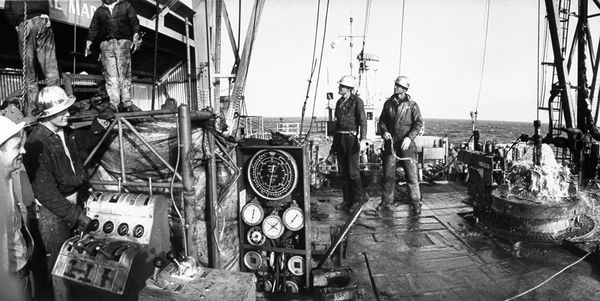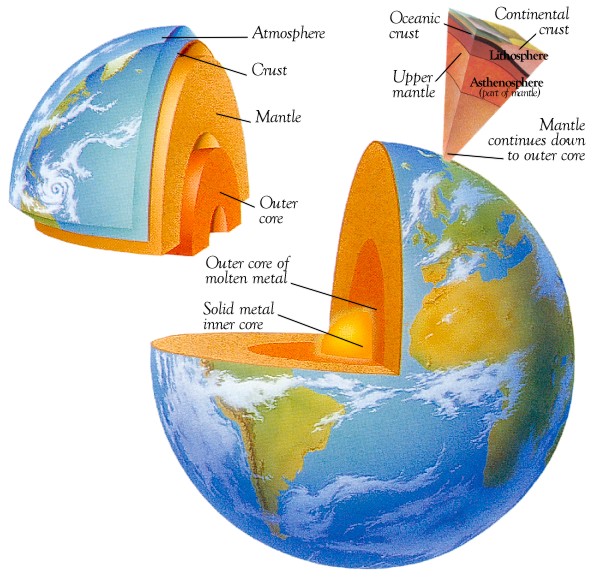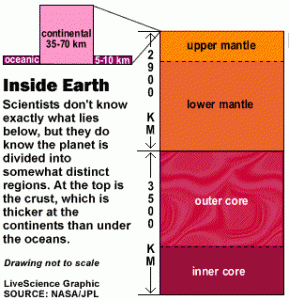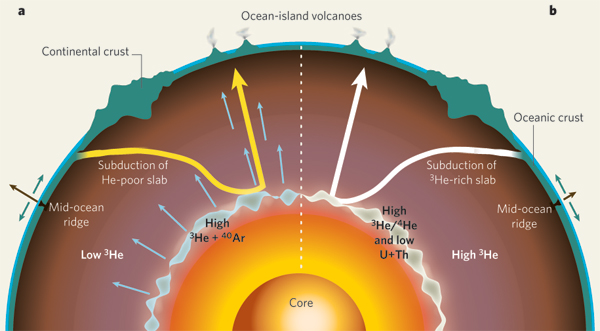Scientists plan to drill all the way down to the Earth’s mantle

Scientists are planning to drill all the way through the planet’s miles-thick crust to Earth’s deep, hot mantle and retrieve samples for the first time. The samples, they say, would rival moon rocks for sheer scientific import—and be nearly as hard to get.
Scientists, led by British co-chiefs, Dr Damon Teagle of the National Oceanography Centre in Southampton, England and Dr Benoit Ildefonse from Montpellier University in France, have announced jointly in an article in Nature that they intend to drill a hole through the Earth’s crust and into the mantle – a feat never before accomplished, much less seriously attempted. The last attempt to drill into the mantle, Project Mohole, was conducted in 1961 off Baja California. Although it failed, it’s drill location could be the site of a new effort along with two other potential sites being assessed, including the one being actively investigated off Costa Rica.
A lack of suitable technology and insufficient understanding of the earth’s crust have long tempered the long-time ambition of scientists. Drilling would tell scientists not only what the mantle is like, but also reveal the nature of the Moho layer, a shadowy transitional layer at the base of the crust. Scientists would also be able to look for signs of life in the deep crustal rocks. Mantle rocks would also provide insight into how current mantle processes operate—highly important in understanding the plate tectonics that drive many earthquakes, tsunamis, and eruptions.
 The Earth’s mantle is the part of the planet that lies between the crust and the iron ball at its center, and to reach it, would require drilling down from a position in the ocean, because the crust is much thinner there. Even still, it would mean drilling through five miles of solid rock. And if that doesn’t sound hard enough, temperatures increase the farther down you go, and could reach as high as 570 degrees Celsius – high enough to render useless most modern drill bits. Last but not least is the problem of atmospheric pressure, which increases the deeper you go, to somewhere in the neighborhood of 4 million pounds per square foot near the mantle. That last one may not seem like much of a problem, but with exploratory drilling, it becomes a problem rather quickly when you remember that it’s not just a hole they plan to dig, but a hole that can be used to extract samples from very far below.
The Earth’s mantle is the part of the planet that lies between the crust and the iron ball at its center, and to reach it, would require drilling down from a position in the ocean, because the crust is much thinner there. Even still, it would mean drilling through five miles of solid rock. And if that doesn’t sound hard enough, temperatures increase the farther down you go, and could reach as high as 570 degrees Celsius – high enough to render useless most modern drill bits. Last but not least is the problem of atmospheric pressure, which increases the deeper you go, to somewhere in the neighborhood of 4 million pounds per square foot near the mantle. That last one may not seem like much of a problem, but with exploratory drilling, it becomes a problem rather quickly when you remember that it’s not just a hole they plan to dig, but a hole that can be used to extract samples from very far below.
To retrieve a sample, the drillers would have to rely on drills without a riser (drills that use double pipes for venting gases) which would mean pumping seawater down into the hole through the drill pipe with sufficient pressure to force whatever is being dug back up to the surface so that it can be examined.
This would not be the first time that a sample of the mantle would be recovered however, as volcanoes and such have been forcing under-crust material to the surface for eons; it would be the first time that a sample was found though that hasn’t been tainted by the process that brought it up to us, and that scientists say, is worth whatever the cost might add up to over time as the project carries on through years of laborious drilling.
The pair plan to begin searching for a suitable site somewhere in the Pacific this spring, but don’t expect the technology, nor the funding to allow them to start drilling till perhaps 2018.
Journey to the mantle of the Earth by Damon Teagle & Benoît Ildefonse
Oceanic crust (grey) is subducted into Earth’s interior at continental boundaries and, after residing in the deep mantle for a while, either mixes back into the convecting mantle or rises in plumes (large arrows) from the core–mantle boundary.
 The best place to drill is in the mid-ocean, because that’s where Earth’s crust is thinnest—only about 6km (4 miles) thick, versus tens of kilometers deep in continental regions.
The best place to drill is in the mid-ocean, because that’s where Earth’s crust is thinnest—only about 6km (4 miles) thick, versus tens of kilometers deep in continental regions.
But the mid-ocean, is, of course, still deep—about 4 kilometers (2.5 miles) in the targeted areas. That’s nearly twice the depth reachable by today’s offshore drilling techniques. So far, drills have penetrated only about 2 kilometers (1.2 miles) into undersea crust.
There’s no danger of a blowout, such as the Gulf oil spill, because there are no oil and gas deposits in the mid-ocean for the drill to accidentally penetrate, he added. Nor would the mantle rocks suddenly erupt out of the hole, since the channel would be narrow and mantle rocks aren’t molten.
“There is a risk of failure in that the hole could collapse,” scientist said, “but there is no perceived environmental risk.”
Because the earth is very hot inside, a current of heat flows from the core to the crust. This is called convection current and it also takes place in the mantle. This current cools down as it comes closer to the surface of the earth. As a result, the rising of the current decreases and goes into horizontal direction along the bottom of the crust. When the current cools down more, the convection current descends again and goes to the inner earth. There the temperature increases and the current rises again. This goes on and on.
When the current comes at a weaker part of the crust, for example at a volcano, magma comes above the earth’s surface. The convection current along the bottom of the crust causes the moving of the tectonic plates. This is called plate tectonics. The movement of these plates goes very slowly. The bumping of two tectonic plates causes an earthquake.
The Integrated Ocean Drilling Program (IODP)
Magma “Ocean” May Have Flowed Inside Early Earth
Learn more about Inner core and Inside Earth
“First Contact With Inner Earth”: Drillers Strike Magma
New Magma Layer Found Deep in Earth’s Mantle?
Hole Drilled to Bottom of Earth’s Crust, Breakthrough to Mantle Looms
Chikyu drill prepares to pierce Earth’s mantle


Is the mantle habitable or is it all lava and deadly vapors and fumes to clay rocks and acids dripping all over.